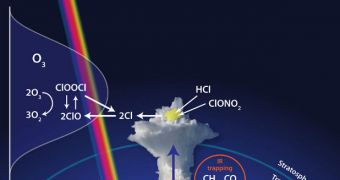Atmospheric scientists in the United States have determined in a new study that massive storm clouds trigger the same atmospheric processes that have given rise to the hole in the ozone layer, above Antarctica. The phenomenon is localized in the region exactly above them.
The polar ozone layer hole was caused by excessive concentrations of chlorofluorocarbons (CFC) in the atmosphere. These dangerous chemicals were banned by an international UN moratorium, signed in Montreal back in 1986.
An interesting aspect of the new study was discovering that ozone destruction occurs above clouds in the same way it did above Antarctica, even though the root causes of the degradation are completely different. Only big summer storm clouds were observed to produce this effect.
These clouds extend beyond the troposphere – the first layer of the atmosphere – and into the stratosphere, where 90 percent of the ozone is located. The chemical is extremely important because it forms a layer that protects Earth from excessive exposure to ultraviolet radiations.
Ozone (O3) is usually attacked by molecules called free radicals, such as reactive chlorine and bromine. The reaction occurs at very low temperatures, such as those above the poles. However, the team found that another factor can trigger the process.
Apparently, storm clouds that increase the concentration of water vapors in the lower troposphere can act as catalysts for this destructive reaction, knocking one atom from the O3 molecule and converting it into O2 (basic oxygen). The resulting chemical does not provide shelter from UV radiation.
“Anytime you satisfy the proper concentration of water and temperature, these reactions will take place,” says Jim Anderson, who holds an appointment as an atmospheric chemistry professor at the Harvard University. He was also the lead author of the investigation.
“These convective storms inject water far more deeply into the stratosphere than anybody ever suspected, and that immediately began to concern us,” Anderson says, in an interview for Our Amazing Planet.
The top of clouds produced by these storms reaches altitudes in excess of 9 and 12 miles (15 and 20 kilometers), high enough to impact the lower troposphere, and cause the unfavorable changes.

 14 DAY TRIAL //
14 DAY TRIAL //